Did you know what last week’s object of the week was?
Well done if you recognised last week’s object was our Acorn Barnacle (Semibalanus balanoides).
Barnacles are Crustaceans that have adapted to a sessile life; once the young barnacle larva has found a place to live, it attaches to a surface and will stay there for the rest of its life. They feed by filtering food particles out of the water with their feathery arms. Unlike most other Crustaceans they do not shed their external shell.
When Darwin undertook his study of Barnacles this was only some years after they had been reclassified from Molluscs (their hard external shell had led anatomists to believe they should be classed with limpets). Darwin had only intended to study one species of barnacle, but after spending over a year studying them he realised the extent of the work there was to be done on the taxonomy of the group.




